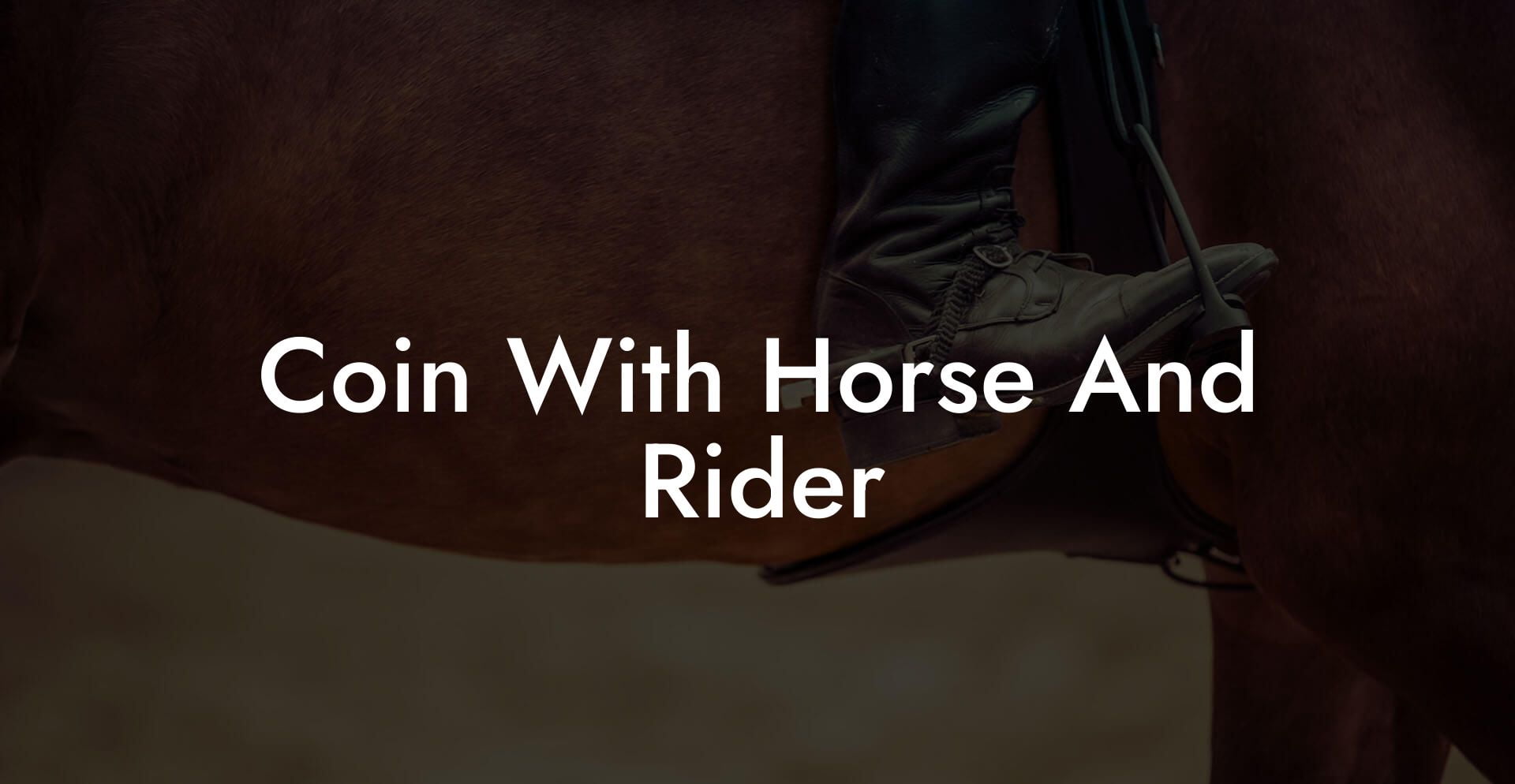Ever stumbled upon a coin that features a magnificent horse and its daring rider, and felt an electric buzz of inspiration to care for your very own equine companion? That’s the vibe we’re channeling here! This isn’t just about collecting rare coins or drooling over historical memorabilia, it's about igniting a passion for horse care that’s as timeless as those vintage coins. Whether you’re a first-time equestrian or a seasoned rider looking for fresh insights, consider this your ultimate, down-to-earth guide to nurturing your four-legged friend, all while embracing an attitude that’s equal parts cool, quirky, and utterly dedicated.
Quick Links to Useful Sections
- The Epic Tale Behind the Coin With Horse And Rider
- Horse Care 101: Crafting Your Legendary Partnership
- 1. Building a Strong Foundation With Daily Grooming
- 2. Mastering the Art of Feeding and nutrition
- 3. Exercise and Movement: The Heartbeat of Equine Health
- Bonding Beyond the Basics: Creating Trust and Connection
- Incorporating Modern Training Techniques
- Health and Wellness: Keeping Your Equine at the Top of Their Game
- Preventative Care: The Cornerstone of Equine Health
- Dealing with Common Ailments
- Technology in Equine Health
- Practical Tips and Tricks for the Modern Horse Enthusiast
- Streamlining Routine Tasks With Technology
- Eco-Friendly and Sustainable Practices
- Creating a Customized Stable: Safe, Stylish, and Functional
- Leveraging Online Communities and Workshops
- Sustainable and Ethical Practices in Modern Horse Care
- Resources and Community Support: Your Next Steps
- Crafting Your Personalized Horse Care Blueprint
- Step 1: Comprehensive Health and Lifestyle Assessment
- Step 2: Setting Clear and Achievable Goals
- Step 3: Integrating Modern Tools and Timeless Techniques
- Step 4: Keeping a Daily Routine and Monitoring Progress
- Step 5: Adapting and Evolving With Your Horse
- Real-Life Stories: Transformations in the Stable
- A New Rider’s Tale: From Overwhelmed to Empowered
- A Seasoned Equestrian’s Reinvention
- Overcoming Adversity: The Rescue Horse That Stole Everyone’s Hearts
- FAQs: Your Burning Horse Care Questions Answered
- Your Journey to Legendary Horse Care
The Epic Tale Behind the Coin With Horse And Rider
Picture this: a coin glinting in the sunlight, engraved with the graceful curve of a powerful horse and the determined spirit of its rider. For centuries, these coins have been more than just currency, they've been symbols of courage, unity, and the unbreakable bond between man (or woman) and beast. From ancient empires to modern mints, the imagery tells a story of adventure, balance, and mutual trust.
Historical records suggest that the horse and rider motif first appeared on coins when rulers wanted to showcase their leadership and mastery over nature. It spoke to an era when horses were essential to warfare, travel, and survival. Today, while we might not ride into battle on horseback, the symbolism endures, we now channel that same legacy into caring for our horses with passion and respect.
For the modern equestrian, the coin is a reminder that caring for a horse is both an art and a science. Like a rare collectible, your horse deserves meticulous attention and admiration. In a way, every moment spent grooming, training, or simply bonding with your horse is a nod to a tradition that spans centuries, a tradition celebrating balance, elegance, and the powerful relationship between horse and rider.
Horse Care 101: Crafting Your Legendary Partnership
Let’s break it down: owning and caring for a horse is like curating a masterpiece. Each brushstroke, whether it’s grooming, feeding, or training, adds to the overall picture of a vibrant, healthy life. Here’s where the magic begins: much like the precise engraving on a vintage coin, every detail matters when it comes to ensuring your horse thrives.
First things first: if you’re planning to jump headfirst into the equestrian world, know that preparation is key. Think of it as designing your own signature coin, a symbol that will represent your dedication, style, and care for your horse. Ready to dive in? Let’s explore the fundamental building blocks of exceptional horse care.
1. Building a Strong Foundation With Daily Grooming
Grooming isn’t just about keeping your horse looking Insta-worthy (although that’s a major bonus!). It’s about health, happiness, and extra bonding time. Daily grooming sessions help you monitor your horse’s coat, skin, and overall body condition. Spending 10–15 minutes brushing off dust and tangles not only prevents skin issues but also turns into a therapeutic ritual for both of you.
Pro tip: Use a mix of soft brushes and mane combs to give your horse a spa-day vibe. Engage them with gentle massages, and hey, feel free to toss in a compliment or two, your horse might not talk back, but those eyes sure do sparkle with gratitude!
2. Mastering the Art of Feeding and nutrition
Just like coins are minted with a precise blend of metals, a well-balanced diet is essential for your horse. High-quality hay, grains, and specialized feeds should be at the core of your equine’s diet. Remember, every horse is unique, what works for one might not work for another. Experiment (with vet guidance, of course) to find the perfect mix that keeps your equine both vibrant and vigorous.
Modern horse care goes beyond the basic bowl and haystack. Many riders are now leveraging technology, apps that track feeding schedules, digital reminders for supplement packages, and even smart feeders that adjust portions based on activity levels. This tech-savvy approach isn’t just practical; it’s also a nod to a generation that values efficiency as much as passion.
3. Exercise and Movement: The Heartbeat of Equine Health
A horse’s body is built for movement. Regular exercise isn’t just good; it’s essential. Whether your horse loves a brisk trot across a dewy field or a hardy canter that makes its mane whip in the wind, movement is medicine. Plan out a schedule that includes trail rides, arena work, and simple lunging sessions.
Think of exercise as the dynamic duo long celebrated on that coin. Just as every great rider knows the importance of staying in sync with their mount, you too should monitor your horse’s stamina, flexibility, and overall speed. Interactive training sessions, combined with varied routines, ensure that your horse never gets bored, and neither do you!
Bonding Beyond the Basics: Creating Trust and Connection
At the core of every legendary partnership lies mutual trust. Caring for a horse isn’t merely about the physical aspects; it’s also an emotionally rich journey. Whether you’re a Gen-Z enthusiast or a millennial riding high on nostalgia, building trust with your horse transforms routine care into a deeply rewarding experience.
Spend time simply being together, take a leisurely walk, share a quiet moment under a sprawling oak, or even engage in playful games that stimulate your horse mentally. These moments go far beyond the utilitarian aspects of care; they build a bond that’s palpable, much like the timeless symbol of the horse and rider on a cherished coin.
Incorporating Modern Training Techniques
There’s a new wave of training techniques that blend traditional horsemanship with modern science. Consider incorporating clicker training, a method that reinforces positive behavior through sound and treats. This approach is not only effective but also appealing to a generation raised on instant feedback and gamification. It’s like leveling up in your favorite video game, only the reward is a more confident and cooperative horse!
Additionally, interactive apps and online communities offer a treasure trove of tips and tricks. From video tutorials on advanced maneuvers to digital journals for tracking progress, there’s an abundance of resources that marry ancient wisdom with cutting-edge technology.
Health and Wellness: Keeping Your Equine at the Top of Their Game
Let’s get real, no matter how much you pamper your horse with grooming rituals and training sessions, health must always come first. Just as collectors meticulously examine coins for authenticity and quality, you should be in tune with every nuance of your horse’s well-being.
Regular veterinary check-ups, dental care, and deworming are non-negotiable elements of a comprehensive care plan. A healthy horse means more than just a pretty coat, it’s about ensuring a long, vibrant, and active life.
Preventative Care: The Cornerstone of Equine Health
Routine visits to the vet are critical. Schedule bi-annual check-ups to catch any potential issues before they escalate. Vaccinations, hoof care, and a healthy weight management program go a long way in ensuring your horse’s overall vitality. Don’t let a minor snag turn into a costly health crisis!
Dealing with Common Ailments
Horses, like us, can sometimes face the odd cold or injury. Familiarize yourself with the signs of common issues like colic, laminitis, or respiratory infections. Arm yourself with knowledge and a basic first-aid kit, tailored specifically for equine emergencies. When in doubt, consult your vet, and remember, a little preventive care can save you heaps of stress (and money) down the line.
Technology in Equine Health
Embracing modern tech can make monitoring your horse’s health a breeze. From wearable fitness trackers designed for horses to smart barn sensors that monitor temperature, humidity, and air quality, technology is revolutionizing how we care for our equine partners. This integration not only simplifies the job but also appeals to the tech-minded millennial and Gen-Z crowd.
In essence, staying proactive with your horse’s health is akin to preserving the pristine condition of a limited-edition coin, meticulous care ensures longevity and value.
Practical Tips and Tricks for the Modern Horse Enthusiast
So, you’re ready to step up your horse care game, but where do you start? Here are some practical, modern-day tips that combine the wisdom of the past with the innovations of today:
Streamlining Routine Tasks With Technology
Gone are the days when horse care meant handwritten logs and guesswork. Today’s digital tools allow you to track feeding schedules, medication dates, and training routines with ease. Download an app, set reminders, and let technology handle the routine while you focus on the fun stuff, like exploring new trails or trying out innovative training apps.
Consider investing in a digital health record for your horse. These records help you monitor everything from weight fluctuations to dietary changes, ensuring that you and your vet are always on the same page.
Eco-Friendly and Sustainable Practices
As sustainability becomes a cornerstone of modern living, incorporating eco-friendly practices into horse care is a natural step. Use biodegradable grooming products, opt for locally sourced feed, and integrate sustainable waste management practices in your stable. Not only does this reduce your environmental footprint, but it also aligns your love for horses with a broader commitment to ethical, sustainable practices.
The modern horse enthusiast isn’t just a caretaker, they’re a steward of nature, balancing tradition with the need for environmental responsibility.
Creating a Customized Stable: Safe, Stylish, and Functional
Your horse’s stable is their sanctuary. Invest time in making it a safe and comfortable haven. Ensure your stable is well-ventilated, clean, and designed to facilitate easy movement. Add a bit of personal flair, think of it as designing an environment that echoes the aesthetic appeal of a beautifully minted coin. Clean bedding, appropriate lighting, and even a touch of décor can transform a basic stable into a welcoming retreat for your horse.
Regular maintenance goes a long way in preventing injuries and illnesses. Keep an eye out for any signs of wear and tear, repair broken fixtures, and always maintain a clutter-free environment. A well-organized stable is the foundation for a well-cared-for horse.
Leveraging Online Communities and Workshops
One of the coolest things about being a modern horse enthusiast is the vast, vibrant community at your fingertips. Join online forums, social media groups, and participate in webinars or local workshops tailored to horse care. Whether you’re looking for advice on advanced training techniques or simply want to swap grooming tips, these communities provide a wealth of shared experiences and insights.
Sharing your journey not only enhances your skills but also strengthens the collective knowledge of the equestrian community. It’s a two-way street of learning, laughter, and sometimes, a few meme-worthy moments that remind us all to enjoy the ride.
Sustainable and Ethical Practices in Modern Horse Care
In an era when sustainability is more than just a buzzword, modern horse care insists on ethical and eco-friendly practices. The relationship between a rider and their horse is rooted in mutual respect, a respect that extends to the environment and community as well.
One way to start is by understanding the impact of your stable management on the environment. Choose organic feed options when possible, reduce waste through recycling and composting, and consider solar-powered stable lighting. These practices not only help the planet but also create a healthier living environment for your horse.
Ethics come into play in every decision you make. Whether it’s supporting local, humane breeding farms or ensuring that your training methods are respectful and non-coercive, every action contributes to a legacy of care and compassion. In the same way that a meticulously minted coin reflects the values and culture of its time, your ethical choices reflect your commitment to a kinder, more sustainable future.
Resources and Community Support: Your Next Steps
While reading about horse care is inspiring and educational, nothing beats the real-world experience of connecting with fellow horse enthusiasts. Whether you’re just starting out or you’re a seasoned rider, there are countless resources and communities waiting to help you elevate your equine care routine.
Consider joining local riding clubs, participating in webinars, or even attending horse care workshops. These experiences not only provide practical knowledge but also introduce you to a network of passionate individuals who share your love for horses. And if you ever feel lost or overwhelmed, these communities offer advice, camaraderie, and sometimes even humorous anecdotes about the ups and downs of life in a stable.
From online forums and social media groups tailored to Gen-Z and millennial riders to regional associations dedicated to equine well-being, the support network is vast and vibrant. Share your experiences, ask questions, and never hesitate to seek advice, the equestrian community thrives on collaboration, understanding, and a shared passion for nurturing these majestic animals.
Crafting Your Personalized Horse Care Blueprint
Just as no two coins are exactly alike, every horse has its own personality, needs, and quirks. Crafting a personalized horse care plan means embracing the uniqueness of your equine companion while also drawing on tried-and-true best practices.
Step 1: Comprehensive Health and Lifestyle Assessment
Your journey begins with a thorough assessment of your horse’s physical condition, temperament, and daily routine. Schedule a full veterinary check-up, analyze their dietary needs, and observe their behavior. This foundation helps you identify areas that need attention, be it nutritional tweaks, a revised exercise regimen, or environmental improvements.
Step 2: Setting Clear and Achievable Goals
Define what you want to achieve, are you looking to boost your horse’s overall health? Enhance their performance in the arena? Or simply strengthen your bond? Set measurable goals such as improved stamina, better coat condition, or increased trust through specific training milestones. When goals are clear, every step you take becomes more meaningful.
Step 3: Integrating Modern Tools and Timeless Techniques
Combine digital tools with established horse care practices to create a dynamic routine. Incorporate technology to track feeding, exercise, and health metrics, while simultaneously maintaining daily grooming and natural care practices. This dual approach ensures that you’re always in tune with your horse’s needs.
Step 4: Keeping a Daily Routine and Monitoring Progress
Consistency is key. Create a daily routine that includes designated times for grooming, exercise, feeding, and relaxation. Use digital journals or apps to monitor progress and adjust your approach as needed. Much like collecting a series of rare coins, you’ll begin to notice how each small effort contributes to an overall masterpiece of care.
Step 5: Adapting and Evolving With Your Horse
Your personalized plan should be as dynamic as the bond you share with your horse. Regularly evaluate progress, celebrate the small wins, and adjust routines if challenges arise. Embrace the journey, the ups, downs, and occasional quirky moments that make the story of you and your horse uniquely yours.
With a tailored blueprint in hand, you’re well on your way to creating a nurturing environment that not only meets your horse’s needs but also enriches your own life with purpose, joy, and a dash of adventure.
Real-Life Stories: Transformations in the Stable
Real-life experiences bring heart and authenticity to the art of horse care. Here are a few stories that highlight the transformative power of dedication, modern techniques, and genuine love for these majestic creatures.
A New Rider’s Tale: From Overwhelmed to Empowered
Alex, a self-professed digital native with a hectic city life, always dreamed of owning a horse. When the opportunity finally arose, the excitement was palpable, but so was the overwhelm. With limited experience and a busy schedule, Alex worried that juggling the demands of modern life with horse care would be impossible. By embracing online communities and digital tools, Alex created a well-rounded plan that balanced tech-driven tracking with hands-on care. Slowly but surely, the partnership blossomed. Today, Alex shares regular updates on social media and has become an inspiration for other first-time riders, showing that with passion and a strategic approach, any challenge can be transformed into a rewarding journey.
A Seasoned Equestrian’s Reinvention
Meet Jamie, a lifelong horse lover whose methods were steeped in tradition until the pressures of modern life prompted a fresh look at equine care. Jamie’s breakthrough came when integrating advanced digital tools and eco-friendly practices into an age-old routine. By incorporating sustainable, organic feed options, joining virtual workshops, and even using wearable tech to monitor the horse’s activity levels, Jamie not only enhanced the health and performance of the horse but also reinvigorated a deep-seated passion for the sport. This newfound balance between tradition and innovation reinvigorated Jamie’s approach and served as a compelling example for equestrians looking to merge the best of both worlds.
Overcoming Adversity: The Rescue Horse That Stole Everyone’s Hearts
Then there’s Robin’s story, a rescue horse with a checkered past that many had written off. The journey from fear and mistrust to absolute, unshakeable companionship was anything but linear. With patience, plenty of mindful training sessions, and consistent daily care, Robin’s newfound owner transformed the seemingly lost horse into a spirited, agile partner. “It was like finding a rare coin at a flea market, it took time, effort, and unwavering belief, but in the end, the treasure revealed was priceless,” Robin’s owner recalls. This testament to resilience and the transformative power of conscientious care underscores the timeless bond between rider and horse.
These stories remind us that horse care isn’t just a set of tasks, it’s a narrative of perseverance, joy, and the pursuit of excellence. Whether you’re in the early chapters or already deep into your equestrian saga, every moment spent caring for your horse adds to a vibrant story that’s uniquely yours.
FAQs: Your Burning Horse Care Questions Answered
We know you’ve got questions, and we’re here to answer them with straightforward, no-nonsense advice that resonates with modern horse lovers.
1. What is the significance of the “Coin With Horse And Rider” motif?
The coin symbolizes a timeless bond and balance between the rider and the horse, a relationship marked by trust, strength, and mutual respect that has evolved through centuries.
2. How can modern technology enhance horse care?
Digital tools such as health tracking apps, smart feeders, and online communities make horse care more efficient, personalized, and connected. They provide real-time data and facilitate access to expert advice.
3. What are the best practices for daily grooming?
Daily grooming should include brushing, combing the mane and tail, checking for injuries, and massaging your horse’s muscles. It improves circulation, prevents skin issues, and strengthens your bond.
4. How do I know if my horse’s diet is balanced?
A balanced diet includes quality hay, grains or concentrates suited to your horse’s workload, and all necessary supplements. Regular consultations with your vet or an equine nutritionist can help tailor the perfect meal plan.
5. What should I do if my horse shows signs of discomfort?
Monitor the symptoms closely. If your horse displays unusual behavior, such as decreased appetite, reluctance to move, or signs of pain, consult your veterinary professional immediately.
6. Can I implement advanced training techniques at home?
Absolutely! Methods such as clicker training, mindfulness-based exercises, and positive reinforcement are perfect for progressing at home. Start slowly and research best practices to ensure a safe experience.
7. What sustainable practices can I integrate into my stable management?
Use eco-friendly grooming products, compost waste, source organic feed, and consider renewable energy options for stable lighting. These practices benefit both your horse and the environment.
8. How do I stay connected with the modern equestrian community?
Join online forums, social media groups, attend webinars or local events, and subscribe to equine care newsletters. Networking with fellow enthusiasts can provide valuable insights and inspiration.
Whether you’re asking basic or advanced questions, every query is a step toward better care and deeper connection.
Your Journey to Legendary Horse Care
Just like a rare coin that tells a story of heritage and beauty, your journey in horse care is one of legacy, passion, and endless discovery. Embracing the modern, tech-savvy tools alongside timeless traditions, you’re set to create an experience that is as enriching as it is memorable.
From mastering daily grooming rituals to adopting advanced training techniques, every step you take adds value to your unique bond with your horse. The path isn’t always smooth or predictable, but it’s filled with those golden moments of clarity and connection that remind you why you fell in love with horses in the first place.
Dive in with confidence, celebrate every milestone, laugh through the mishaps, and cherish the journey. Whether you’re crafting your personalized stable routine or connecting with a community of fellow enthusiasts, know that every small effort counts. Your commitment is your legacy, and your horse is your proudest creation.
So go ahead and embrace the inspiration from that striking coin with a horse and rider, a symbol of enduring strength, elegance, and unity. With each day, build a narrative that fuses modern insights with timeless care, ensuring that your horse not only survives but thrives. Your legendary journey in horse care starts here, rich in tradition, glowing with modern creativity, and utterly unforgettable.













